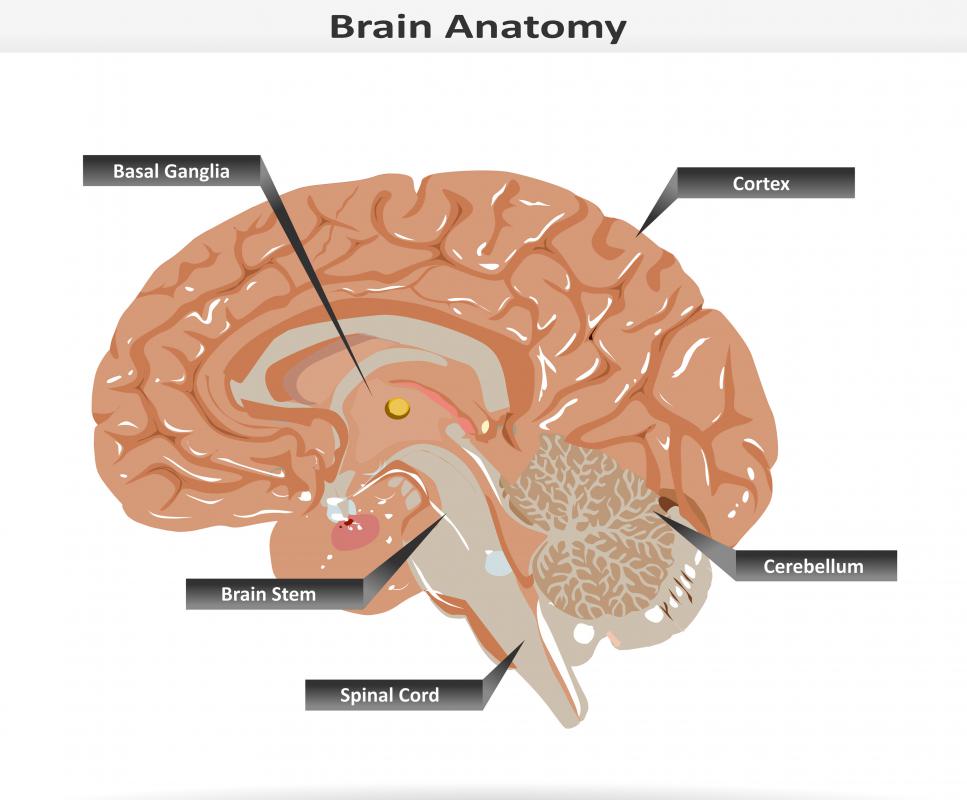At TheHealthBoard, we're committed to delivering accurate, trustworthy information. Our expert-authored content is rigorously fact-checked and sourced from credible authorities. Discover how we uphold the highest standards in providing you with reliable knowledge.
What Is Basal Ganglia Infarction?
Basal ganglia infarction involves a disruption of blood flow in the small arteries located in the white matter of the cerebral cortex. The condition may occur at any age and contributing factors typically evolve around certain existing medical conditions that include blood disorders, diabetes and hypertension along with infections. Symptoms vary with the extent of the blockage and cellular damage. Treatment generally involves correcting the underlying condition, preventing further damage and possibly enduring rehabilitation.
The area known as the basal ganglia refers to a group of basal nuclei lying deep within the forebrain. Regions in this part of the brain include the amygdala, the caudate, the putamen, and substantia nigra. Physicians might refer to these areas of the brain as the corpus striatum, the striatum, or the lenticular nucleus. This is generally the area affected by Parkinson’s disease.

Patients from childhood on may experience basal ganglia infarction one to three months after seeming to recover from bacterial, fungal or viral infections. The organisms generally travel to the brain where they produce inflammation and swelling. The increased pressure prevents normal fluid circulation and may compress or rupture small arteries. Without adequate blood flow, communication between neurons ceases, the brain emits chemical signals, and tissues begin dying.

Studies suggest that 20% of all adulthood strokes are typically located in the basal ganglia. Individuals with diabetes may develop lipid, protein, and sugar molecule coagulations that adhere to the endothelium, the inner lining of arterial walls. Not only do the walls thicken, they also lose elasticity and the passageway, or lumen, narrows. Hypertension often produces endothelial injury causing fibrous scar tissue formation. Chronic inflammatory diseases, including lupus, may also contribute to vessel damage or leakage.

Atherosclerosis frequently causes plaque formations, which adhere to vessel walls or contribute to abnormal clot formation. Blood disorders producing an abundance of blood cells, abnormal blood cells, or causing increased clotting may also block fragile arteries. These afflictions generally include polycythemia and sickle cell anemia.
Individuals with basal ganglia infarction often initially experience severe headaches, nausea, vomiting, and loss of consciousness. Patients may exhibit facial drooping, paralysis on one side of the body, and speech abnormalities. Some develop muscle stiffness or spastic, uncontrollable movements. A mild infarction may affect balance, cause walking difficulty, or the inability to use an arm.

Cognitively, people may exhibit difficulty with comprehension or concentration. Some basal ganglia infarction patients experience personality changes that include symptoms of depression. Others may exhibit extreme anger, lack of motivation, or obsessive-compulsive behavior.
Imaging that evaluates blood flow studies can render a definitive diagnosis. Blood tests generally indicate blood or clotting abnormalities. Physicians generally prescribe anti-infective medications for unresolved infections, and patients may receive clot busting or pain medications and treatments designed to reduce intracranial inflammation and pressure. Individuals experiencing mental confusion, or those unaware of physical deficits, may require safety precautions.
AS FEATURED ON:
AS FEATURED ON:
















Discussion Comments
Is the prognosis good after an attack on the brain such as this?
Your brain basically rewires itself and uses different parts of the brain to compensate for the part of your brain that was injured in the blood flow loss.
Post your comments